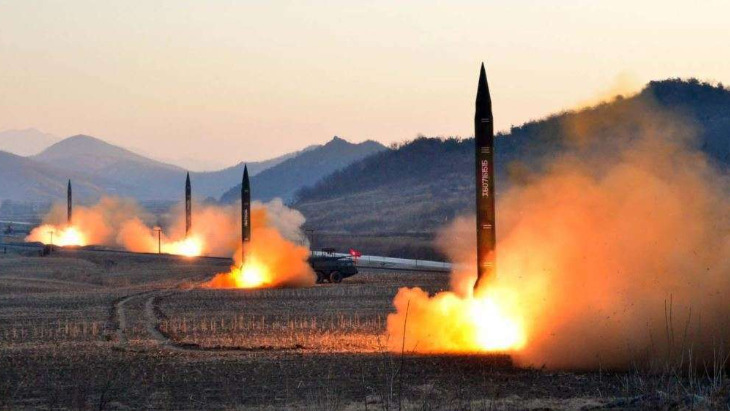 Passover’s Message of Hope in the Aftermath of Oct. 7
Passover’s Message of Hope in the Aftermath of Oct. 7


11 min read
Is there such a thing as a mathematically inexplicable event?
Do you believe in miracles? The answer to that question probably depends on whether you believe in God or not. After all, if there is a God, then He can perform miracles. But without belief in God, one would probably note that there are no miracles that have been verified in a strictly scientific way in modern times. Most “miracles” that are reported can either be explained away as coincidence or lack of verifiable evidence. But is this true of all reported miracles?
In the spring of 1967, Israel found itself surrounded by enemies bent on its imminent destruction. On May 14, Egyptian president Gamal Abdel Nasser ordered a full mobilization of Egypt’s armed forces. On May 27, Nasser proclaimed, “Our basic objective will be the destruction of Israel.”1 Arab troops numbered 350,000 versus the Israeli’s 264,000 troops; the Arabs had 2,000 tanks versus 800 Israeli tanks, and the Arabs had 700 combat aircraft versus 300 Israeli combat aircraft.2
On June 5, the Israeli air force launched a preemptive air strike, destroying most of the Egyptian air force – some 400 combat aircraft – as well as disabling almost all of their airfields. Follow-up attacks quickly destroyed the Syrian and Jordanian air forces as well. With the destruction of Arab airpower, the fate of the Arab armies was sealed. The war lasted only six days and ended with a decisive Israeli victory. Israel’s success appeared to be a direct result of a brilliant and well-executed first strike.
As is often the case with war stories, things were not so simple. Behind the scenes, there were developments that could have resulted in the total destruction of Israel.3 On the morning of June 9, Israel invaded Syria’s Golan Heights. Syria was then a client state of the former Soviet Union. On June 10, Soviet premier Leonid Brezhnev called US President Lyndon Johnson. He told him that the Soviet Union would go to war against Israel if Israel did not withdraw from Syria immediately.
Johnson was not intimidated; he ordered the US 6th fleet stationed in the Mediterranean to advance toward the Middle East. The message to the Russians was clear. Brezhnev became cautious but was still determined to enter the war against Israel. He entrusted this task to Air Colonel General Vasily Reshetnikov, the commander of the USSR’s long-range strategic bombers. Brezhnev ordered him to use those bombers to annihilate Israel.
At that time, Reshetnikov had four squadrons of these bombers stationed in the Ukraine, within range of Israel. They would be fully armed and ready to fly within hours. Brezhnev further required that all Soviet identifying information be removed from the attacking aircraft and their crew members, and the Egyptian insignia should be painted on the bombers. Thus, should a plane be shot down, the Soviets could claim that they had given the aircraft to the Egyptians, thus avoiding a direct confrontation with the Americans.
Israel was winning the war on all three fronts but was unaware of the overwhelming force being prepared to obliterate them. However, one serious problem then presented itself to the Soviets. They needed green paint for the stars in the Egyptian insignia, and there was no green paint to be found in the Ukraine!4 Thus, the bombers were never deployed, and the war was over the next day. For all the Israeli’s ingenuity, meticulous preparation, and brilliant execution of that first air strike, it was a lack of green paint in the Ukraine that saved them from total destruction! Was this just “luck,” or was it a miracle?
There are surely many people who would call this a miracle. But how would a completely objective person know that it was not simply luck? Can one confirm a miracle scientifically? To answer this question definitively, we must jump ahead 24 years.
On January 17, 1991, a coalition of armed forces from 34 countries led by the United States started operation “Desert Storm” to liberate the recently conquered Kuwait from Iraq. Iraq began retaliating the next day. Over a period of several weeks, 39 modified Scud B (Al Hussein) missiles were fired at Israel by Iraq (even though Israel was not one of the 34 country coalition!), with 14 exploding in highly populated residential areas of Tel Aviv and Haifa. (The remainder of the Scuds were either duds, landed in the wilderness, in the Mediterranean, or were intercepted by US Patriot anti-missile missiles.) These Scuds directly killed two Israelis, and 11 were seriously injured.
In 1993, a scientific paper written by Fetter, Lewis, and Gronlund, entitled “Why Were Scud Casualties So Low?” was published in the prestigious British scientific journal Nature.5 An expanded and more detailed version of the paper appeared a few months later.6 The low casualty rate had attracted professional, scientific interest. The paper used a standard mathematical formula to predict the number of casualties expected in any particular missile attack.
 chabad.org
chabad.org
As a test of the formula’s accuracy, it was first applied to the 125 modified Scud B missiles that exploded in Teheran, Iran, between February 29, 1988, and April 4, 1988, during the “War of the Cities” between Iran and Iraq. Reports indicate that, on average, between 9.2 and 16 people in Teheran were killed per Scud. The formula predicts an average of 14.4 deaths per Scud in Teheran. This prediction is accurate since 14.4 is between 9.2 and 16. Similarly, the predicted number of seriously injured per Scud in Teheran, 35.1, is close to the observed value of approximately 32 per Scud.
The Fetter et al. papers offer several possible explanations but finally conclude that there is no evidence for anything more than “sheer luck” involved.7 The Israelis were just very lucky!8
Having established that the formula works well, the Fetter et al. paper applied this formula to the case of the Scud attacks on Tel Aviv and Haifa. The formula predicted that the 14 scuds that exploded in Tel Aviv and Haifa’s residential areas should have resulted in 21 deaths and 61 seriously injured.9 This is significantly larger than the two deaths and 11 serious injuries that occurred. The paper notes that the total number of casualties caused by all fourteen Scud explosions in Israel is less than the average number of casualties caused by a single missile explosion in Teheran”.10 How does one explain such an incredible discrepancy?
The Fetter et al. papers offer several possible explanations but finally conclude that there is no evidence for anything more than “sheer luck” involved.11 The Israelis were just very lucky!12
Consider the following chart of casualties from Scud explosions inside Israel and anywhere else in the world. Does this look like luck?
| In Israel | ||
| # casualties | #Scuds | Place; date |
| 0 | 2 | Tel Aviv; 1/18/91 |
| 0 | 1 | Haifa; 1/18/91 |
| 0 | 4 | Tel Aviv; 1/19/91 |
| 1 | 1 | Tel Aviv; 1/22/91 |
| 1 | 4 | Tel Aviv; 1/25/91 |
| 0 | 1 | Tel Aviv; 2/9/91 |
| 0 | 1 | Tel Aviv; 2/12/91 |
| ___ | ___ | |
| 2 | 14 | Average casualties per Scud: 0.14. |
| Outside Israel | ||
| # casualties | #Scuds | Place; date |
| 29 | 5 | Riyadh & Dhahran, Saudi Arabia; 1/18/91 – 2/25/91 |
| 21 | 1 | Dezful, Iran; 10/27/82 |
| 25 | 1 | Bakhtaran, Iran, 4/4/85 |
| 11 | 1 | Hamadan, Iran; 4/4/85 |
| 25 | 1 | Sana’a, Yemen; 5/11/94 |
| 6 | 1 | Aden, Yemen; 5/22/94 |
| 13 | 1 | Sana’a, Yemen; 5/24/94 |
| 27 | 1 | Grozny, Chechnya; 10/21/99 |
| 17 | 1 | Grozny, Chechnya; 10/21/99 |
| 141 | 4 | Aleppo & Tal Rifaat, Syria; 2/19/2013 |
| 20 | 1 | Hretaan, Syria; 3/29/2013 |
| ___ | ___ | |
| 335 | 18 | Average casualties per Scud: 18.61 |
Why is it that all the casualties from Scuds in other countries conform to the formula but not Israel?
The average number of casualties per Scud is 133 times higher outside Israel than in Israel! Note that the list of attacks outside Israel is comprehensive; it is the result of an extensive Google search for all Scud attacks anywhere in the world and where the parameters of the formula for expected casualties are known so that the formula can be used. As for other attacks inside Israel, calculations of expected casualties compared to actual casualties from missile attacks on Israel during the 2006 Lebanon war and the 2008 Gaza war are consistent with the dearth of actual casualties reported for the Persian Gulf War.
In Tel Aviv, a total of 28 buildings containing 118 apartments were destroyed, and 2,493 apartments were heavily damaged. In Haifa, 1,700 apartments were seriously damaged. Lewis et al. remark that the number of apartments in Tel Aviv that were destroyed or seriously damaged agrees with the formula’s prediction.13 Yet, only two people were killed and 11 seriously injured in Israel! Apparently, the occupied buildings are not protected; only the people in them! Who could control this? Why is it that all the casualties from Scuds in other countries conform to the formula but not Israel? Why is it that the total number of casualties from all 14 Scuds that exploded in Tel Aviv and Haifa is less than the casualties from a single Scud exploding anywhere else? Can it truly be accounted for by luck?
There is a way of evaluating if an unlikely event can reasonably be attributed to luck. We need to calculate the probability of the event occurring by chance and see if it is very small. If the probability is “too small,” then it becomes unreasonable to attribute the event to luck. “Too small” is usually defined in the technical, scientific, and medical literature as no larger than 0.05 (that is, 1/20); occasionally as no larger than 0.01 (1/100).
The Fetter et al. papers do not calculate the probability of expecting 21 deaths and observing only 2, or of expecting 61 serious injuries and observing 11 by chance. Still, we can: the probability of observing two deaths (or less) by chance (i.e., luck) is 0.000000184 (1/5,434,783). The probability of the dearth of serious injuries happening by chance is 0.00000000000000426. That is, approximately one in 234 trillion!14 This is well over a thousand times more significant than the values calculated for some of the latest scientific discoveries (e.g., gravitational waves, the Higgs Boson)!
In real life, this does not happen. The probability of these casualties being so low just by chance or luck is so tiny as to be well beyond the significance required for acceptance by any scientific journal. We can reject the possibility of the small number of deaths and serious injuries happening by chance (that is, luck) with absolute certainty. Many people have called the events of the Persian Gulf War a miracle, especially those who saw the events firsthand. For those intellectuals who require hard evidence before drawing any conclusions, we have provided evidence that meets the highest scientific standards.
This article is excerpted and adapted from The Cosmic Puzzle by Harold Gans, Feldheim, 2020.
For more content like this, please visit www.beyondbelief.blog
